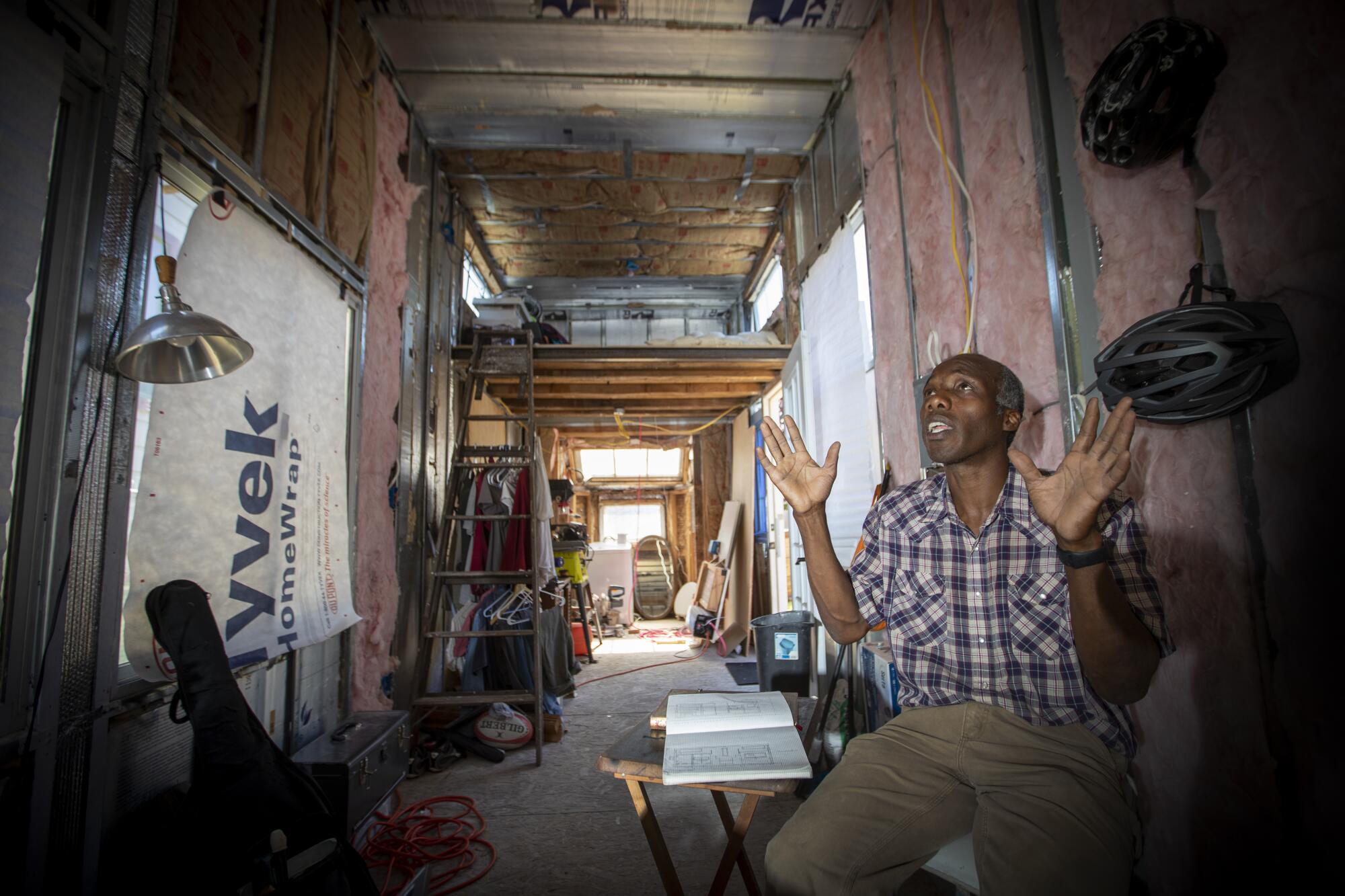
- Share via
OAKLAND — Oliver Burke could have joined his Silicon Valley counterparts who cashed in precious stock options and pumped their newfound riches into start-up businesses, bigger houses and fancier cars.
Instead, he looked at the wreckage just beyond the glistening tech world — the tent cities beside seemingly every freeway onramp, the destitute neighborhoods — and decided to take a different path. A former motor test technician for Tesla, Burke used $200,000 from his company stock options to buy a corner lot in a struggling Oakland neighborhood to create a new home.
For the record:
9:39 a.m. Oct. 22, 2019An earlier version of this article incorrectly stated that Oliver Burke was giving his property to a housing cooperative. He is selling the property to the cooperative at a below-market price, and helping with the financing on the deal.
For someone else.
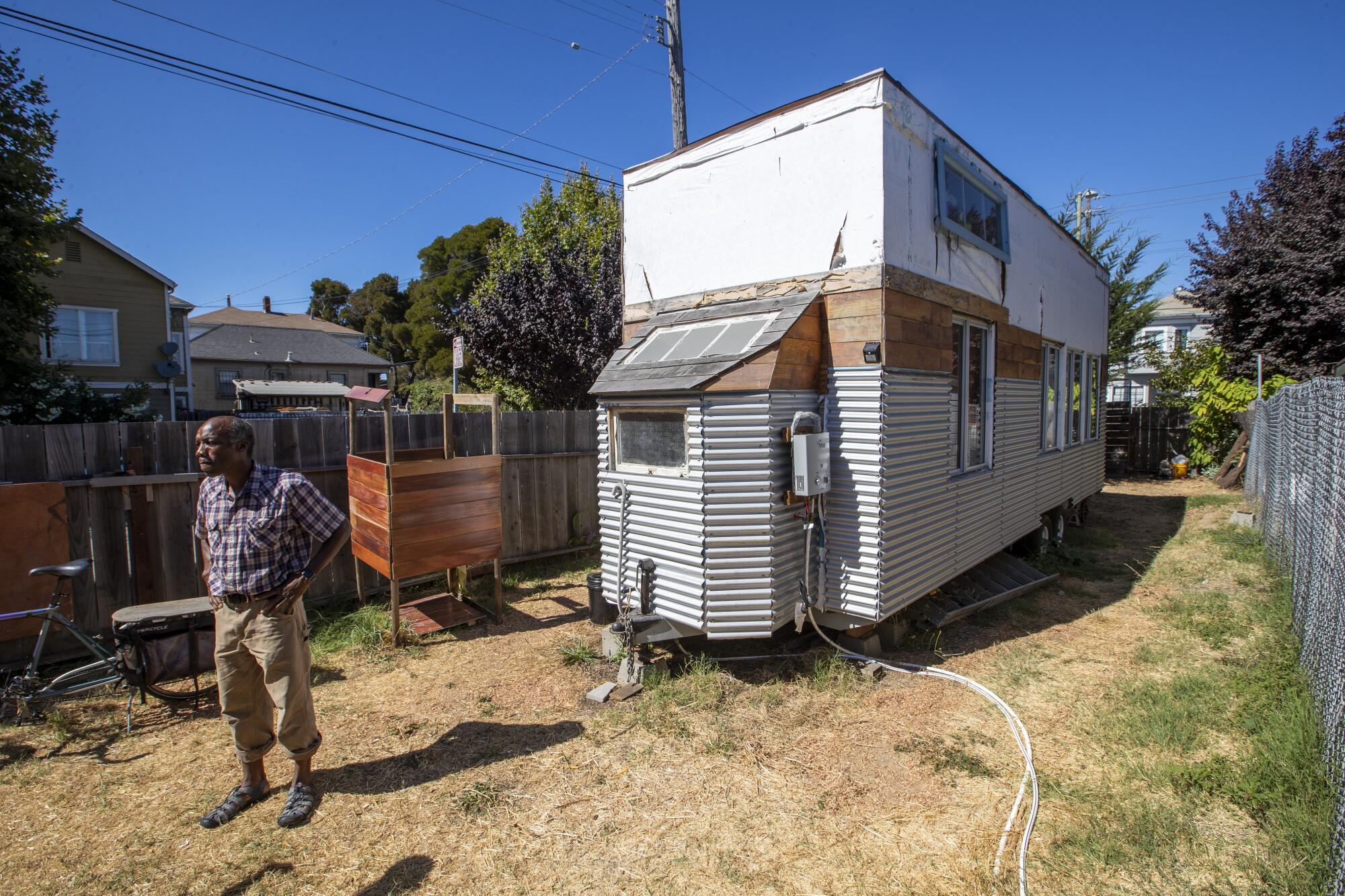
He is in the process of selling the weedy, junk-strewn property in the Lower Bottoms neighborhood to a real estate cooperative at a below-market price. The coop, in turn, plans to build as many as six homes for people who might otherwise be driven away by the San Francisco Bay Area’s rapacious real estate market. Burke is helping with the financing, and a deed restriction will keep the homes affordable in perpetuity.
“I saw a hell of a lot of people in need,” said Burke, 46. “If this prevents a conventional developer from displacing people with another $1-million-plus house and it improves the lives of four people, or maybe six people, to me that’s a good multiplier of resources.”
He and an unknown number of like-minded souls are creating a small undercurrent against the onrushing tide of escalating home prices and gentrification sweeping many California cities. There’s no name or central organization for their movement, just people gifting property to create affordable homes, pooling resources to keep property off the speculative real estate market and adopting “justice easements” designed to keep housing affordable for the long run.
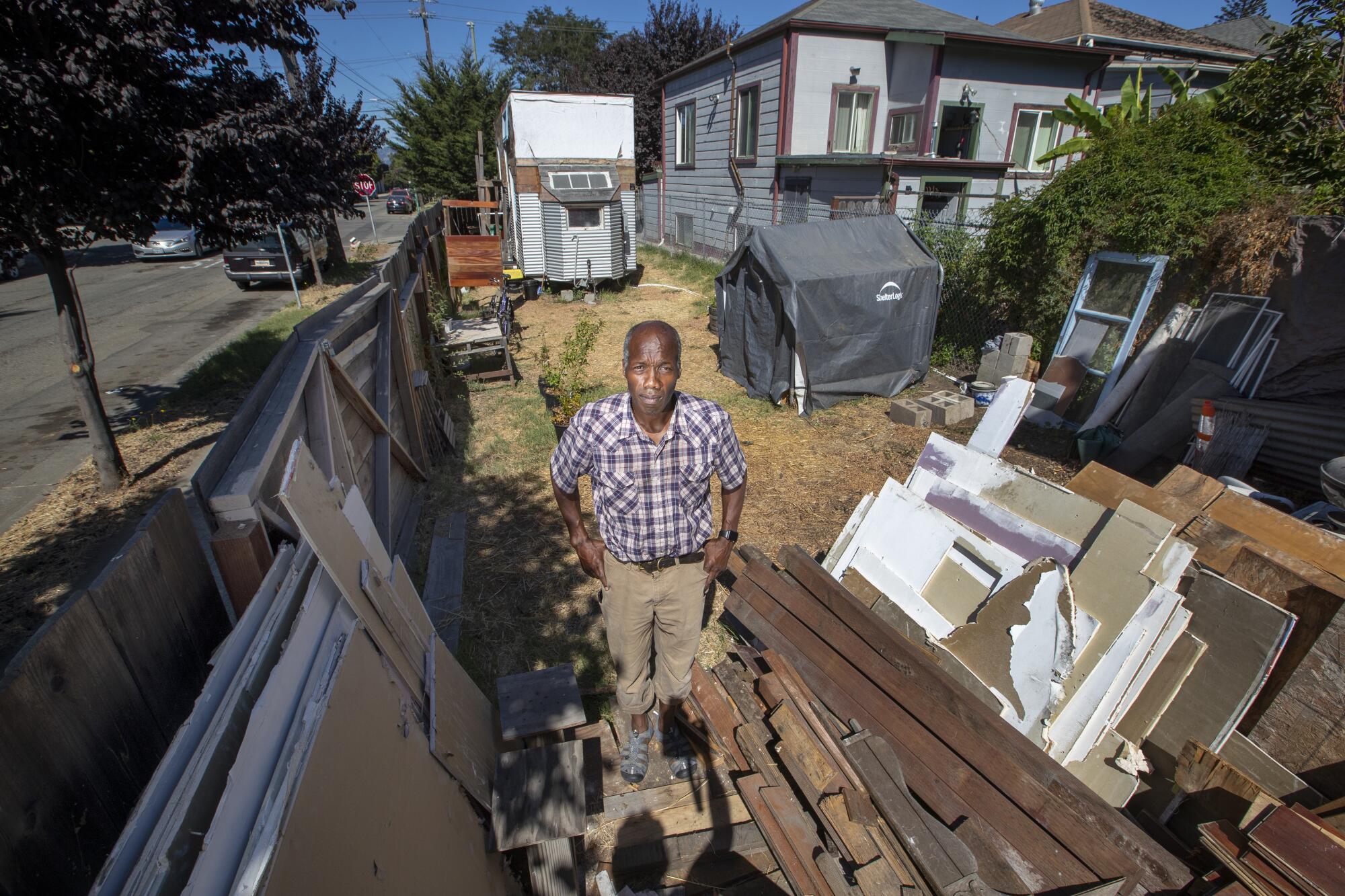
Much of this activism calls for a radical rethinking of the American dream of homeownership. Advocates say they are pushing back against the cutthroat culture of real estate speculation, displacement and gentrification — imagining a day when instead of owning a home for personal use and eventual profit, Americans would tend to property for themselves and their community, with the promise of limited, or no, long-term financial gain.
“Part of what we will need to turn things around in this world is to have people become really dedicated and affectionate land stewards,” said Janelle Orsi, founder and executive director of the Sustainable Economies Law Center.
Orsi’s public interest firm is crafting the “justice easements” to lock in affordability. Like agricultural easements designed to preserve farmland, the justice easements will designate housing as the only appropriate land use, with an additional requirement — that future rent increases be limited to, for instance, hikes in the consumer price index.
The activists say that such dramatic initiatives are needed because traditional affordable housing developers guarantee sub-market rents for only a limited period, of, say, 40 years.
Orsi and allies so far have made only a tiny dent in the Bay Area’s $1.2-trillion real estate market. The profit motive still drives the vast majority of deals, so removing properties from the speculative market feels “un-intuitive,” said Daryl Fairweather, chief economist for the internet-centric real estate brokerage Redfin. Still, she said, this kind of activism could gain momentum in politically liberal communities.
This is not the first time that activists have intervened to short-circuit runaway real estate markets. So-called limited equity housing cooperatives have popped up before in places as far-flung as Vermont, Minnesota’s Twin Cities and the Pacific Northwest. In Los Angeles, co-op evangelist Lois Arkin gathered community donations in the early 1990s to buy and renovate a dilapidated apartment building northwest of downtown. The Los Angeles Eco-Village now includes 47 units spread across three buildings where tenants pay, at most, half the going rent in the surrounding neighborhood — which can be $1,250 for a single apartment.
Over the last decade, Oakland has seen rents in once affordable neighborhoods spiral upward by 80% to an average of $2,314, according to Axiometrics. Over the same period, median home prices have more than tripled, to $718,000. The high costs help explain how Oakland, a hub of African American history and culture, has seen its black population slip from a plurality in 2000 to minority status today, behind whites and Latinos.
Neither market forces nor local government is stemming the tide. About 9,000 housing units are currently under construction in Oakland, with roughly the same number in the “planning pipeline,” but only a bit more than 10% of those homes will be designated for low-income or very low-income tenants, said Maryann Leshin, deputy director of the city’s Housing and Community Development Department.
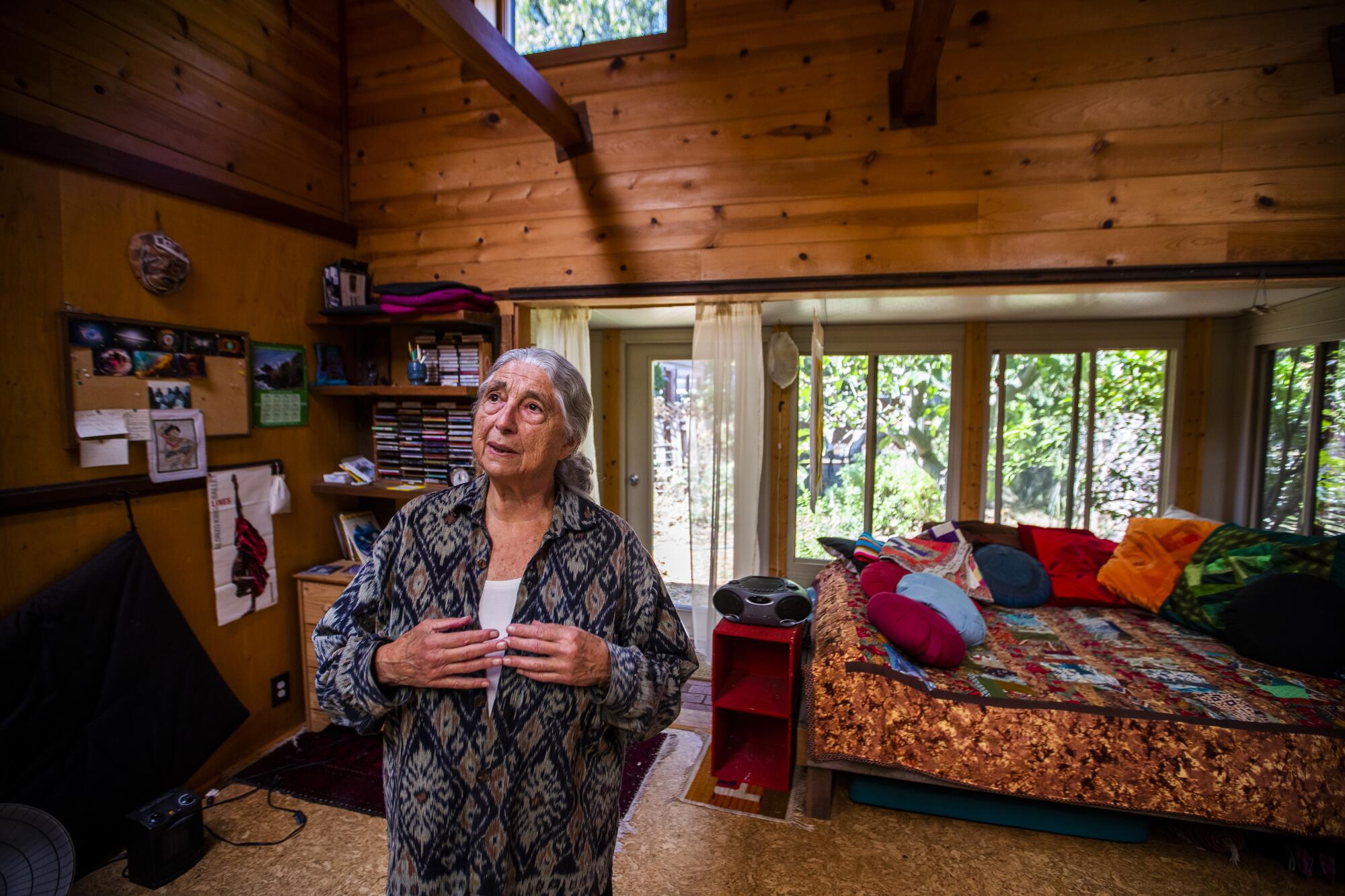
Burke and his ideological soul mates intend to push back against those trends. Among them are:
- Carolyn North, a writer and dance therapist who has agreed to donate her $1.3-million Berkeley home to the East Bay Permanent Real Estate Cooperative to create affordable housing for artists. North has given her three adult children what she believes is a fair inheritance. She doesn’t see why she, or they, should get a huge payday for a home she and her late husband bought in 1966 for just $28,000. “Anyone in this neighborhood can sell their home and make a huge bundle and give it to their kids. And they are already privileged white kids,” said North, 81, who plans to move to a cooperative farm in nearby El Sobrante. “You just perpetuate a whole system I would like to see changed. Somebody has to demonstrate a different way of thinking.”
- Friends from Oakland City Church who bought a fourplex in 2018 to prevent high rents from driving them out of the Fruitvale neighborhood. The pair of government workers and three teachers who joined in the purchase agreed they wanted homes, not an investment. They plan to adopt a deed restriction, or other legal device, so a reasonable price on the property will be maintained after they are gone. “We wanted to keep it affordable for the next generation,” said partner Susan Broadnax, a retired federal home loan bank employee.
- Four renters in North Oakland who feared displacement when their landlord painted their building “gentrifier gray” and put it on the market. They turned to the East Bay Permanent Real Estate Cooperative and the Northern California Land Trust, which helped buy the fourplex. One key: securing a $600,000 loan from the city of Oakland, which is investing $12 million from a local bond measure earmarked for land trusts and cooperatives to create “permanent affordability.”
- Dixi Carrillo, who was offered $1.4 million by a real estate developer for a seven-unit apartment building and instead sold it to the Oakland Community Land Trust for $1.1 million. The trust has kept rents about $1,000 in a neighborhood where the units could fetch two to three times that much. “It stays affordable forever and ever and ever,” said Carrillo, 75, a photographer. “I loved the idea of that.”
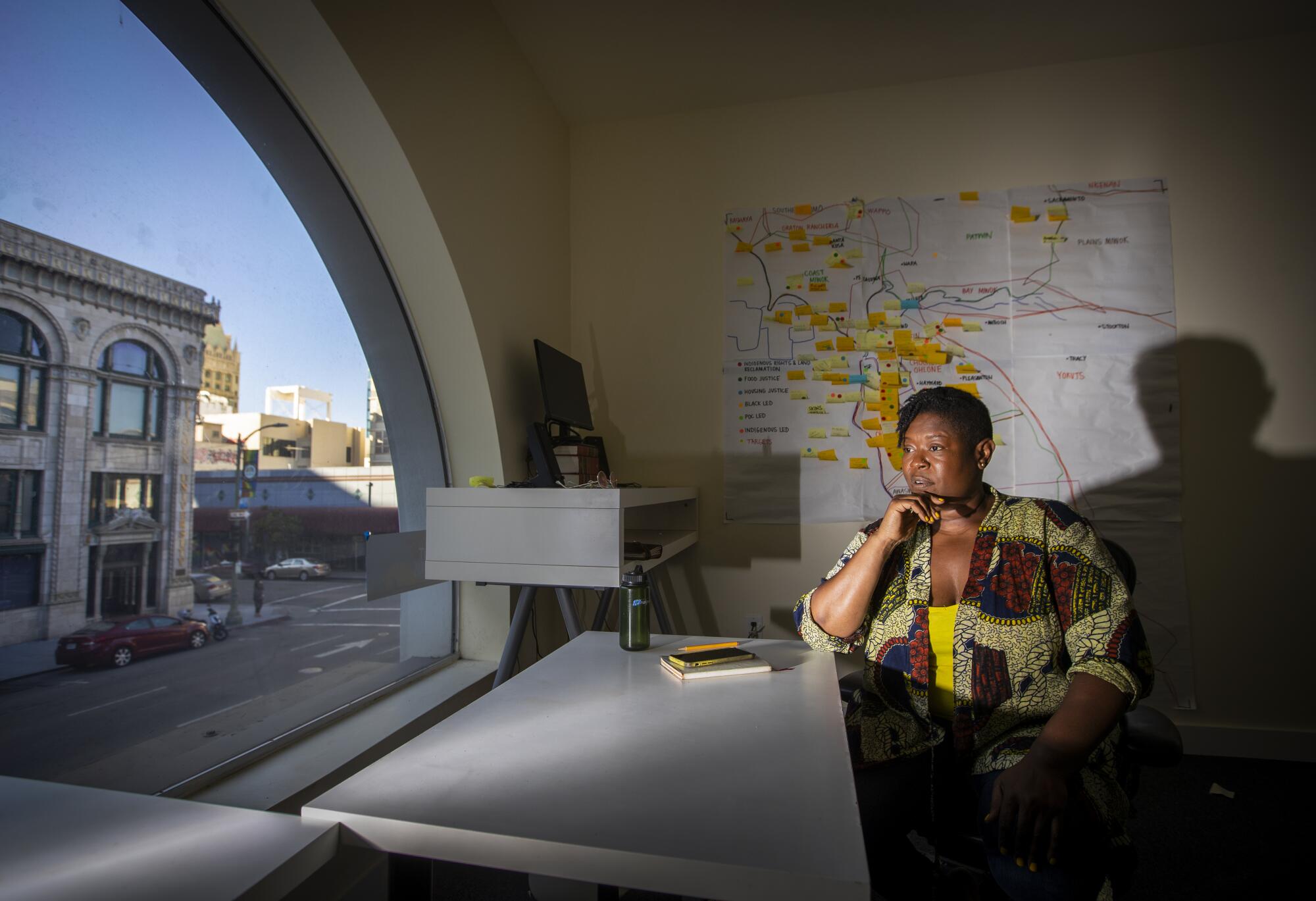
To get broader community buy-in for creating permanent affordability, Orsi’s public interest law firm and People of Color Sustainable Housing Network joined in 2016 to form the East Bay Permanent Real Estate Cooperative. The organization has persuaded 157 “community investors” to put up $1,000 each. They get the promise of a modest 1.5% return and the group’s pledge to pool the money to buy Oakland homes and keep them relatively cheap.
Much of the first round of funding went to assist with the purchase of the North Oakland fourplex. “I hope to avoid pushing more people out of Oakland,” said Nancy Moore, 70, a self-defense instructor and former lawyer who invested $1,000. “Maybe we can help the young artists and musicians who are just trying to have a toehold here.”
Raising money for affordable housing is only one challenge. Each deal can bristle with logistical hurdles. The donation of North’s over 100-year-old Victorian will require five legal agreements. They will include the justice easement, to define how a land trust controlling the property will cap rents and any eventual sales price, and a contract outlining how future residents will manage the home cooperatively.
No one said that being in the housing reform vanguard would be easy. The Oakland church group took pains to find a building where elderly, disabled or low-income renters wouldn’t be displaced. But the group still had to pay state-mandated charges to move out previous tenants, at a cost averaging about $15,000 per unit.
With one prior tenant still in place, Broadnax has been left to “couch surf” in an adjacent unit with her friend and co-owner Norma Sherman, a retired Alameda County employee. “We were sensitized to not victimizing anyone else when we chose our property,” Broadnax said. “But now we have been so busy trying to find a legal way forward to complete the move. It takes all our time and focus.”
There have been wild fluctuations in the amount of government money available for creating permanently affordable homes. Following the financial crisis a decade ago, the federal government gave cities and counties $6 billion to buy foreclosures under the Neighborhood Stabilization Program. Once that money had been spent, however, the number of projects promising long-term affordability declined sharply.
That left community groups and individuals to fill the void. But it’s not clear how many will follow trailblazers like Oakland’s Burke and Berkeley’s North, both old hands at bucking convention.
Burke is a Jamaican immigrant, a rugby player and do-it-yourselfer who is building his own tiny home on wheels, which he plans to move to a lot in the Oakland Hills. He feels his life will be more harmonious if he does something about the problems he sees, by making his Lower Bottoms property available to house the poor. “Be the change you want to see in the world,” he said.
North is a freethinker who already has founded a nonprofit that gives excess restaurant food to the poor and donated a farm to a Sonoma County land trust. She said she finds more fulfillment in building community, rather than personal wealth.
“Everybody is thinking about affordable housing and trying to figure it out,” said North, whose three-bedroom home will soon go to struggling artists. “When you break the ice and do something different, suddenly everyone gets very creative. It’s my hope that people get very, very creative.”
More to Read
Sign up for Essential California
The most important California stories and recommendations in your inbox every morning.
You may occasionally receive promotional content from the Los Angeles Times.











